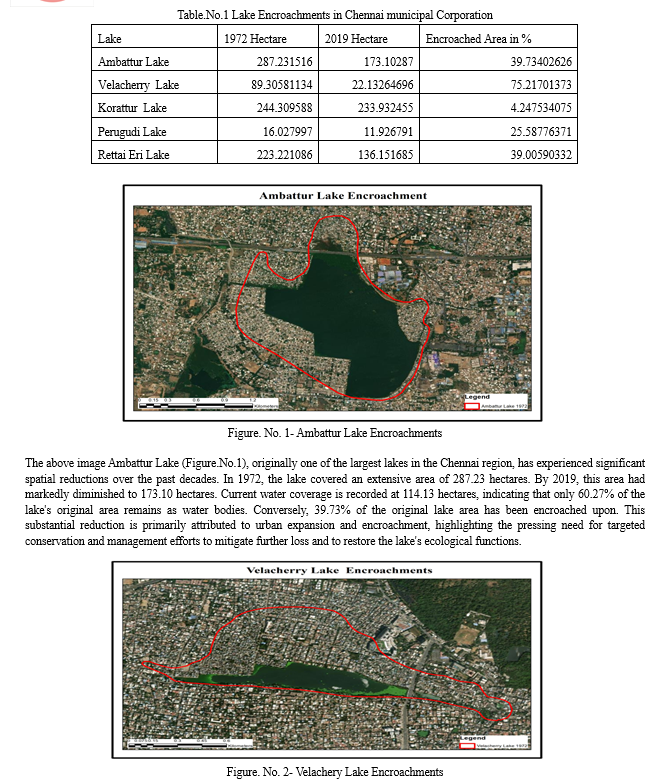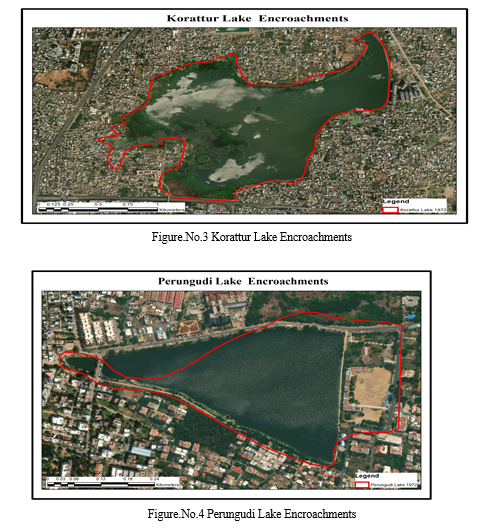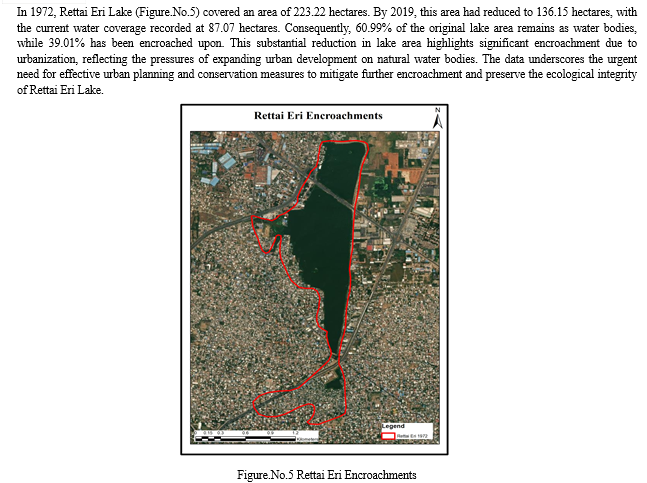Ijraset Journal For Research in Applied Science and Engineering Technology
- Home / Ijraset
- On This Page
- Abstract
- Introduction
- Conclusion
- References
- Copyright
Impact of Rapid Urbanization and Encroachment on the Major Lakes of Chennai: A Spatial Analysis
Authors: Imrana Banu F, Chandrasekar V, Shaik Mahamad, Ravi Kumar P
DOI Link: https://doi.org/10.22214/ijraset.2024.63809
Certificate: View Certificate
Abstract
The rapid urbanization and encroachment in Chennai have significantly impacted five major lakes from 1972 to 2019. By overlaying historical lake boundaries from 1972 toposheets onto 2019 satellite images, substantial reductions in lake areas due to urban expansion are revealed. The lakes analyzed include Ambattur, Velachery, Korattur, Perungudi, and Rettai Eri. Velachery Lake is the most affected, retaining only 24.78% of its original area, with 75.22% encroached upon. Ambattur Lake has 60.27% of its area remaining, while 39.73% is encroached. Korattur Lake remains largely intact with 95.75% of its original area preserved and only 4.25% encroached. Perungudi Lake shows 74.41% remaining area and 25.59% encroachment. Rettai Eri Lake retains 60.99% of its original area with 39.01% encroached. These findings underscore the urgent need for effective urban planning and stringent regulatory measures to protect and restore these critical water bodies. The data-driven insights provided can inform policymakers and urban planners to devise strategies aimed at mitigating the adverse effects of encroachment, ensuring the sustainable management and ecological integrity of Chennai\'s lake ecosystems.
Introduction
I. INTRODUCTION
Urbanization, encroachment, and industrialization have significantly impacted the health of urban lakes, leading to their rapid deterioration. These water bodies, once thriving ecosystems, are now struggling under the weight of pollution and unsustainable development practices. The consequences are far-reaching, affecting not only the environment but also human health and safety. Urbanization has transformed landscapes, replacing natural habitats with concrete structures. This change disrupts the natural hydrological cycle, reducing the infiltration of rainwater and increasing surface runoff. According to Singh et al. (2017), urban runoff often carries pollutants such as heavy metals, oils, and chemicals into lakes, leading to eutrophication and the degradation of water quality. This process accelerates the growth of algae, which reduce the oxygen levels in water, affecting the survival of fish and other aquatic life.
Encroachment on lake areas for residential, commercial, and industrial development further exacerbates the problem. Illegal settlements and construction activities near lakes not only reduce the area of these water bodies but also contribute to pollution. According to Prasad et al. (2018), encroachment leads to the dumping of solid waste and sewage directly into lakes, raising levels of harmful contaminants such as nitrates, phosphates, and heavy metals. These pollutants significantly alter the chemical composition of the water, making it hazardous for both aquatic life and human use. Industrial activities contribute heavily to the pollution of urban lakes. Factories often discharge untreated or inadequately treated effluents into nearby water bodies. These effluents contain toxic substances, including heavy metals like lead, mercury, and cadmium, which accumulate in the sediment and aquatic organisms. A study by Sharma et al. (2019) found that industrial pollution is a major source of water quality degradation in urban lakes, leading to increased levels of chemical oxygen demand (COD) and biological oxygen demand (BOD). High COD and BOD levels indicate the presence of organic pollutants that consume oxygen, making the water uninhabitable for most aquatic species.
The deterioration of urban lake water quality has several adverse effects. One significant consequence is the increased frequency and severity of urban flooding. Encroachment and loss of natural lake buffers reduce the capacity of lakes to absorb and store rainwater, leading to higher runoff and flooding during heavy rains. According to Kumar et al. (2020), urban lakes play a major role in flood managements, and their degradation poses a significant risk to urban areas. Moreover, polluted lakes pose serious health risks to nearby communities. These Contaminated water will spread of waterborne diseases such as cholera, dysentery, and hepatitis. Additionally, heavy metals and toxic chemicals in polluted lakes can enter the food chain, posing long-term health risks to humans.
Chennai, a rapidly growing metropolitan area, exemplifies the challenges faced by urban lakes in India. The lakes managed by the Chennai Municipal Corporation are in a dire state due to rampant urbanization, encroachment, and industrial discharge.
Studies have shown that many of these lakes have high levels of pollutants, including nitrates, phosphates, and heavy metals (Prasad et al., 2018). The situation is exacerbated by illegal dumping of solid waste and sewage, which further degrades water quality and reduces the lakes' ability to support aquatic life. Flooding is a significant problem in Chennai, with urban lakes losing their capacity to mitigate heavy rains due to encroachment and pollution. The degraded state of these lakes has led to frequent urban flooding, causing extensive property damage and posing risks to human safety. Efforts by the Chennai Municipal Corporation to restore and manage these lakes have been initiated, but the scale of the problem requires more comprehensive and sustained action. The deterioration of urban lakes due to urbanization, encroachment, and industrialization is a pressing issue that demands immediate attention. The consequences of poor water quality in urban lakes extend beyond environmental degradation to significant public health and safety risks. A concerted effort involving strict enforcement of environmental regulations, sustainable urban planning, and community participation is essential to restore and preserve these vital water bodies. In cities like Chennai, addressing these challenges is crucial for ensuring the resilience and sustainability of urban ecosystems.
II. AIMS & OBJECTIVES
A. Aims
To assess the extent and impact of urban encroachment on the lakes managed by the Chennai Municipal Corporation.
B. Objectives
To analyze the encroachment of selected lakes within the Chennai Municipal Corporation.
III. METHODS
The Toposheets (1972) and Google earth Image have been used for various years to denote the shrinkage of the lake overlay Techniques.
Table.No.1 – Chennai Toposheet
|
Toposheet Number |
Scale |
Year |
Source |
|
66c/4 |
1: 50,000 |
1972 |
Survey of India |
|
66c/5 |
1: 50,000 |
1972 |
Survey of India |
|
66c/8 |
1: 50,000 |
1972 |
Survey of India |
IV. RESULT AND DISCUSSION
A. Analysis of Lake Encroachments
The provided data presents a comprehensive analysis of the spatial changes in six significant lakes in Chennai over the period from 1972 to 2019. This study involves an overlay analysis where the lake boundaries extracted from 1972 Toposheets were superimposed onto 2019 satellite images. This method reveals substantial alterations in the lake areas, predominantly due to urban development and encroachment.
The lakes included in this analysis are Ambattur Lake, Velachery Lake, Korattur Lake, Perungudi Lake, Rettai Eri Lake, and Kallu Kuttai Lake. By comparing the lake areas in hectares across these two time points, the study highlights the current water coverage, the percentage of remaining water bodies, and the extent of encroached areas. The results indicate significant reductions in lake sizes, with notable encroachment impacting the ecological and hydrological functions of these water bodies. The comparison shows a stark decrease in the area covered by water, reflecting the intensity of urban expansion and the pressures exerted on natural resources.
This analysis underscores the critical need for effective urban planning and stringent regulatory measures to protect and restore these vital water bodies. The findings provide a data-driven foundation for policymakers and urban planners to devise strategies aimed at mitigating the adverse effects of encroachment and ensuring the sustainable management of Chennai's lake ecosystems.

The above image (Figure.No.2) interprets the encroachments of the lake. In 1972, Velacherry Lake encompassed an area of 89.31 hectares. However, by 2019, this area had drastically reduced to 22.13 hectares. The current water coverage now stands at 67.17 hectares. This means that only 24.78% of the lake's original area remains as water bodies, while a substantial 75.22% of the land has been encroached upon. This extensive encroachment highlights the severe impact of urbanization on Velacherry Lake, significantly diminishing its ecological and hydrological functions. The data underscores the critical need for effective management and restoration strategies to address the challenges posed by urban expansion and to preserve the lake's vital environmental roles.
In 1972, Korattur Lake (Figure. No 3) spanned an area of 244.31 hectares. By 2019, this area had slightly decreased to 233.93 hectares, with the current water coverage being 10.38 hectares. Notably, 95.75% of the original lake area remains intact, with only 4.25% of the land encroached upon. This minimal encroachment indicates that Korattur Lake is the least affected by urban development pressures among the lakes studied in Chennai. The data suggests effective conservation efforts or comparatively lower pressure from urban expansion, which has helped maintain the lake's ecological and hydrological functions. In 1972, Perungudi Lake (Figure. No. 4) encompassed an area of 16.03 hectares. By 2019, this area had decreased to 11.93 hectares, with the current water coverage standing at 4.10 hectares. Consequently, 74.41% of the original lake area remains as water bodies, while 25.59% has been encroached upon. This moderate level of encroachment suggests that, although urbanization has impacted the lake, a substantial portion remains relatively intact. The data highlights the need for ongoing conservation efforts to preserve and protect the remaining water bodies from further encroachment and to maintain the lake's ecological functions.


Conclusion
The comprehensive analysis of six significant lakes in Chennai reveals the profound impacts of urban development and encroachment on these vital water bodies. By overlaying historical lake boundaries extracted from 1972 toposheets onto 2019 satellite images, the study highlights substantial reductions in lake areas, primarily driven by urban expansion. Ambattur Lake experienced a significant reduction, shrinking from 287.23 hectares to 173.10 hectares. Currently, only 60.27% of the original lake area remains as water bodies, with 39.73% encroached upon. Velachery Lake shows a drastic reduction from 89.31 hectares to 22.13 hectares. Today, only 24.78% of the lake\'s original area remains, while 75.22% has been encroached upon. Korattur Lake, which covered 244.31 hectares, saw a slight decrease to 233.93 hectares. Remarkably, 95.75% of the original lake area remains intact, with only 4.25% encroached upon. Perungudi Lake reduced from 16.03 hectares to 11.93 hectares. Currently, 74.41% of the original area remains as water bodies, with 25.59% encroached upon. Rettai Eri Lake decreased from 223.22 hectares to 136.15 hectares. Presently, 60.99% of the original lake area remains as water bodies, while 39.01% has been encroached upon. Velachery Lake is the most affected by urbanization, with only 24.78% of its original area remaining and 75.22% encroached upon. The findings from this study emphasize the critical need for effective urban planning and stringent regulatory measures to protect and restore these vital water bodies. The data-driven insights provided can inform policymakers and urban planners in devising strategies aimed at mitigating the adverse effects of encroachment and ensuring the sustainable management of Chennai\'s lake ecosystems. Continuous monitoring and proactive management are essential to preserve the ecological and hydrological functions of these lakes, thereby supporting the environmental health and resilience of the urban landscape.
References
[1] Geena Prasad (2018). \"Impact of Urbanization on Land Use and Land Cover Changes: A Case Study.\" Journal of Environmental Management, 212, 245-256. https://doi.org/10.1016/j.jenvman.2018.01.017 [2] Kumar, S., Singh, P., & Singh, R. (2020). \"Urban Flooding and Its Mitigation Measures: A Case Study of Chennai.\" International Journal of Disaster Risk Reduction, 45, 101451. https://doi.org/10.1016/j.ijdrr.2019.101451 [3] Lines, J. (1995). \"Evaluating Land Use Changes for Environmental Sustainability.\" Environmental Impact Assessment Review, 15(3), 163-180. https://doi.org/10.1016/0195-9255(95)00022-F [4] Prasad, R., Sharma, A., & Singh, G. (2018). \"Encroachment and Its Impact on Urban Lakes: A Case Study of Chennai.\" Water Science and Technology, 77(12), 2994-3003. https://doi.org/10.2166/wst.2018.196 [5] Sharma, A., Gupta, N., & Kaur, H. (2019). \"Industrial Pollution and Its Impact on Urban Lake Water Quality.\" Environmental Monitoring and Assessment, 191, 362. https://doi.org/10.1007/s10661-019-7515-4 [6] Singh, P., Kumar, S., & Thakur, R. (2017). \"Urban Runoff and Its Impact on Water Quality of Urban Lakes.\" Journal of Water Resources Planning and Management, 143(8), 05017005. https://doi.org/10.1061/(ASCE)WR.1943-5452.0000784 [7] Sobana Leena R. (2014). \"Land Use Dynamics and Its Impact on Water Resources: A Case Study.\" Applied Geography, 49, 1-10. https://doi.org/10.1016/j.apgeog.2013.11.001
Copyright
Copyright © 2024 Imrana Banu F, Chandrasekar V, Shaik Mahamad, Ravi Kumar P. This is an open access article distributed under the Creative Commons Attribution License, which permits unrestricted use, distribution, and reproduction in any medium, provided the original work is properly cited.

Download Paper
Paper Id : IJRASET63809
Publish Date : 2024-07-30
ISSN : 2321-9653
Publisher Name : IJRASET
DOI Link : Click Here
 Submit Paper Online
Submit Paper Online

